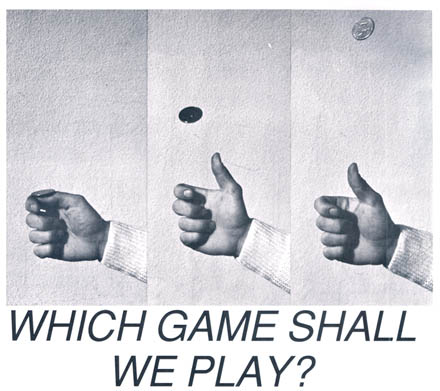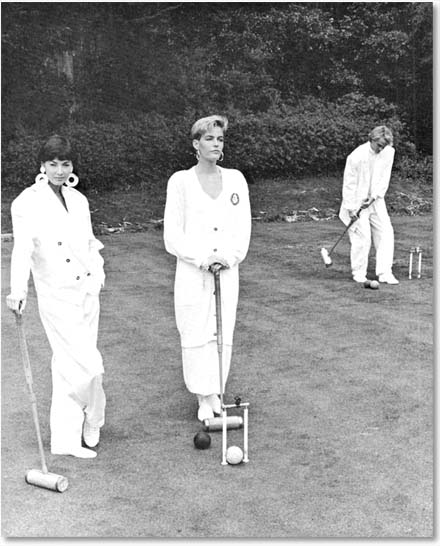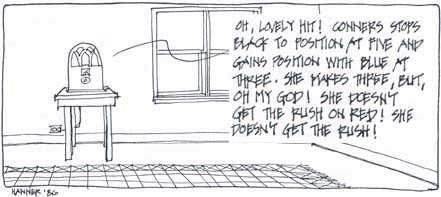

|
Back to |
| The Front Page |
| News & Features |

|
When Association Croquet was outlawed in America |
|
by Mike Orgill, Bob Alman, and Hans Peterson layout by Reuben Edwards Posted September 11, 2015
|
The year 1987 was a watershed year in American croquet, when the USCA's brilliant founder and then-president Jack Osborn created a national controversy by actively suppressing the play and promulgation of the form of croquet played in other countries and promoted by their national associations. The main focus of his ire was the American West, where players in Arizona and Northern California dominated the championships, but attracted only a tiny fraction of the membership boasted by the more socially oriented Eastern croquet clubs. A rival association was formed by Stan Patmor of Arizona, and the San Francisco Croquet Club was the only big club in the West not to withdraw from the USCA. This had to be the lead story in the second issue of the black-and-white magazine started by Hans Peterson, Mike Orgill, and Bob Alman in the Peterson apartment in Berkeley early in 1987. Mike was assigned the interviews with both Osborn and Stan Patmor, reluctant president of the rival ACA. Here's the complete interview with Osborn, along with some interspersed commentary from 2015 on how things actually worked out.
Jack Osborn and the USCA Response
Mike Orgill: What is your reaction to the formation of the American Croquet Association?
Jack Osborn: I think they are tying themselves to an unfortunate direction. The International game is not particularly suited to the broader tastes of the American croquet playing population. The International game is less tactically involved and far less interactive. The game we fortuitously evolved into is a very fine game. I am not saying that the British game doesn't have its merits, but it does not have appeal to the greatest number of American players. We are in fact dedicated to serve the far larger body of players.

|
| Hans and Bob art-directed the cover subject on American-style Croquet Politics of the late 80's. Mike photographed it, with the dark background offering sufficient contrast to allow the reversed-out type to be readable. (It's enhanced here by the layout editor to make it work in this size.) The setting is the original single lawn of the San Francisco Croquet Club in Stern Grove, uneasily shared with golfers and popularly known at the time as "the San Francisco Hill Course." The club's two new lawns were being built in Stern Grove nearby. The speakers are, left to right: Virginia Snyder at age 85; the late John Taylor; a very pleasant woman attracted to the club by the Osborn-inspired propaganda suggesting that croquet players were wealthy and socially elite; and Bob Alman, who gave himself the tag line. |
Orgill: Could you give me some background on the United States Croquet Association (American) rules? Nobody seems to know the exact history of the rules, how they came about, and how they were originally formulated. Why was deadness originally included?
| THE FLOWERING OF PROFESSIONAL CROQUET |
|
With professional croquet seeming to germinate in the mid-1980's, Brice Jones hired Neil Spooner to oversee the World Croquet Championship at Sonoma-Cutrer, and Meadowood Resort invited Damon Bidencope to oversee the sport on its two courts, with Peyton Ballenger and Jerry Stark part of the staff. After Jerry was left as the lone pro, he ran a golf croquet-only program until his death, now taken over by Mike McDonnell. To my knowledge there are today no more than three full-time croquet pros in the US, plus several part-timers who run tournaments and give paid lessons to individuals and groups. Without the larger player base many of us envisioned, professional croquet remains an unfulfilled dream. Volunteers provide 99 percent of all croquet management in instruction in America today.
|
Orgill: How widely was the game played at that time?
Osborn:: At the turn of the century, when croquet was enjoying its highest popularity, literally hundreds and hundreds of thousands of people both here and overseas played croquet. It has been unfortunate, but the more scientific the game became, the more regimented it was, the narrower the hoops, the bigger the courts, all of these factors, along with the interruption of the two World Wars, led ultimately to the slow but sure disintegration of the number of people played the game. When we first started the USCA, the 9-wicket court setting was obviously the dominant one, and when it came time to form the USCA, hammering out the various alternative rules played by the five original USCA clubs was no easy task. Had the USCA tried to mandate that we were to give up the rules as we had all been playing them for 10 or 20 or 30 years prior to that, there would be no association today. So the carry forward of the deadness and the rotation and many of the other unique qualities of the American game were a direct result or being very pragmatic. Believe me, there were countless meetings between the heads of these five different clubs.

|
| Illustrating a story about the conflict between two different sets of rules could best be done with a coin toss, we decided. The hand model doing the coin toss is Hans, and the photographer is Mike. |
Orgill: Which clubs were involved in those discussions?
| MIXING BIG MONEY AND MAJOR SPONSORS |
|
Big money arrived with the Croquet Classic tournament at Meadowood, which boasted a $30,000 purse in its first year, in the late 80's. Seagram's, in a joint venture with Domain Mumm, was the main sponsor, and the entertainments were spectacular--especially a medieval-themed banquet in a huge cask-lined hall at Merryvale Winery in St. Helena which famously and somewhat predictably ended with a food fight inspired by excellent wine and the medieval custom of eating with one's fingers and without the conventional modern implements. Bob Alman tells people he left when he was hit by a flying chicken, and it's probably true.
|
Orgill: I thought it was an historical thing that came down from the East Coast and the Hollywood players.
Osborn: It was the game they played, essentially. But again, both those groups played only nine-wicket. They never played six-wicket. And only a group in Southampton that were totally unconnected to the Hollywood or the literary set were playing with the Duke of Marlborough, and he was playing fifteen miles away from the Westhampton Mallet Club's courts. They were playing six wicket and Westhampton was playing nine wicket. After a series of exchange tournaments and events between England and Westhampton, we were able to hammer out and codify the rules that embraced obviously a lot of what had become, if not written in stone, the attitude of the American croquet player. We wouldn't be an association today if it were not for having carried those forward. The current USCA management committee are considering new rules that have been developed by a broad-based rules committee. Whatever they decide on will be the new rules as of the first quarter of 1987. Just as the International rules are not cast in stone, our rules are forever evolving. The emphasis on this particular upcoming set of changes is more on clarification than on substance. We have reached the end of any further effort at making them more like the International rules, because, quite frankly, the American game suits the American people and their life style and their sporting style in a far more realistic way than the International rules. Had we gone to the International rules we would not be an association today. You may or may not agree with that, but that's were it's at.

|
| The old CROQUET MAGAZINE was intended to be a "lifestyle" quarterly on the sport. As the bunch of radicals referred to by the East Coast croquet establishment as "the San Francisco roughnecks" on public turf, we enjoyed the irony of portraying in our elegant magazine an excess of style over substance. We were pioneering the sport on public turf, in a big way, with the first two-lawn croquet club in the country newly built by a government entity in a public park. An article called "Strategic Style" featured properly bored-looking models impeccable dressed in all-white. The women are wearing various forms of cotton, and the male model is attempting some kind of roll shot in "a classic linen suit featuring an oversized jacket and pleated pants." The photographer is Karen Thompson. |
Orgill: Do you think that the international competition between the USCA and international players will be affected in any way by this?
| "WESTERN KILLERS" RUINING THE SPORT |
|
Osborn published a diatribe in the late 80's about the players in the West intent on competing abroad. They needed difficult (tight) hoops to toughen them up for international competition. I phoned Osborn to buy from his Palm Beach company some "Foxy" wickets with narrow "spikes" to hold them in place without damaging Oakland's bowling lawns. When I asked if he could give us a narrower setting than these hoops usually had, Osborn erupted, "Don't you guys want anybody to go through your hoops, ever...?" and slammed down the phone. I called back immediately and ordered the Foxy hoops from his assistant. They didn't work very well for our purposes, but Don Oakley later supplied us with "spear" hoops without fins or carrots that did the job for us in Oakland with sufficient stability added by their greater length to be used in a USCA national championship in Association Croquet.
|
Osborn:: Not at all. What is overlooked by newcomers to the game is that the USCA has been playing against and with the International players for six or seven years now. And in fact, the Great Britain team is coming to play in our seventh International challenge cup in April. This series has always been played half under International rules and half under USCA rules. Additionally, a new series between the British Croquet Association and the USCA is scheduled to begin in England in 1988, the USA in 1989 and England in 1990. These meetings, proposed last year by Britain, will be played under the International laws with the "Solomon Trophy" going to the winning country each year. At home, we are expanding our USCA schedule to include the USCA National International Rules Championships to be held for the first time at the Bon Vivant Country Club, in Bourbonnais, Illinois on June 10 through 13. Top finishers in this tournament, as well as the USCA Singles and Doubles Championship in Newport, will qualify for selection to our USCA "Solomon Trophy" team to tour Great Britain in 1988.
Orgill: What is your feeling about the professionalism that seems to be stirring around?

|
| The guys recruited other Western players to contribute to our pioneering black-and-white lifestyle magazine. Among them was Mike Hanner of Oregon, who fantasized a time when major croquet events would be broadcast nationally, with play-by-play commentary. |
Osborn: I don't' see much likelihood of any significant event along those lines in the next few years. I suspect there will be one sooner or later. Again, we run a fundamentally amateur sport association in the eyes of the Federal government, and any association that switches otherwise, find themselves in some tax problems as a consequence. It think that where we are going to see professionalism--and we are going to encourage it with a great deal more emphasis here with our new facility--will be in the professional instruction level. We are focusing on that quite heavily. One of the crying needs, as you can appreciate, is the need for trained and skilled instructors, which by their nature will have to be paid and compensated. So we're looking at an expansion of that end of the professional thing. I'm sure there will surface, from time to time, thoughts in terms of professional tournaments. We at the USCA, along with our fellow members of the newly formed World Croquet Federation, have this subject high on the list of matters affecting our sport that will be discussed at our next meeting.
Mike Orgill, long-time and current president of the celebrated Sonoma-Cutrer Croquet Club in Northern California, is still enjoying a distinguished career in our favorite sport, and is to be inducted into the 2015 CFA's Hall of Fame.
Hans Peterson, recently turned 50, was an important figure along with Mike Orgill in building of the San Francisco Croquet Club as the strongest club of its time in America, and has returned to the sport recently with his family to live near the three-court Sarasota Croquet Club in West Florida, where he is today one of the top players at the club which replaced the San Francisco Croquet Club as America's national model for public court croquet.
Bob Alman soldiers on in the sport at the age of 76 as a programs consultant and every-Saturday instructor for novices at the National Croquet Center he moved east to organize and manage in 2000. He has been the editor of CROQUET WORLD ONLINE MAGAZINE since founding it in 1995, shortly after putting up the first USCA website upon the insistence of the SFCC's Silicon Valley players who told him, "The World Wide Web is going to be the next big thing."